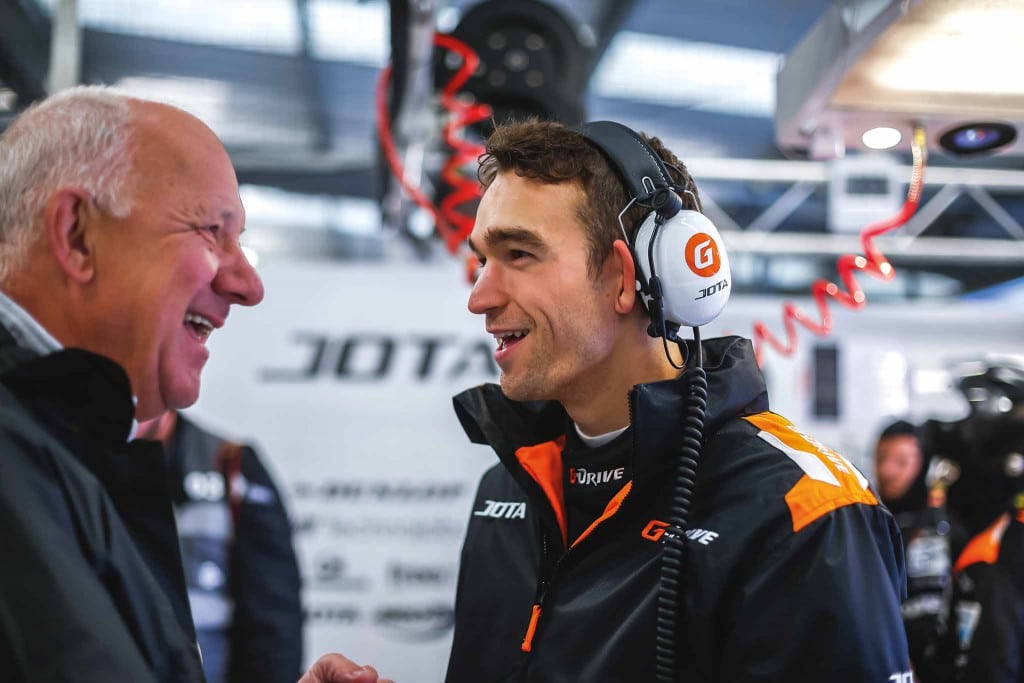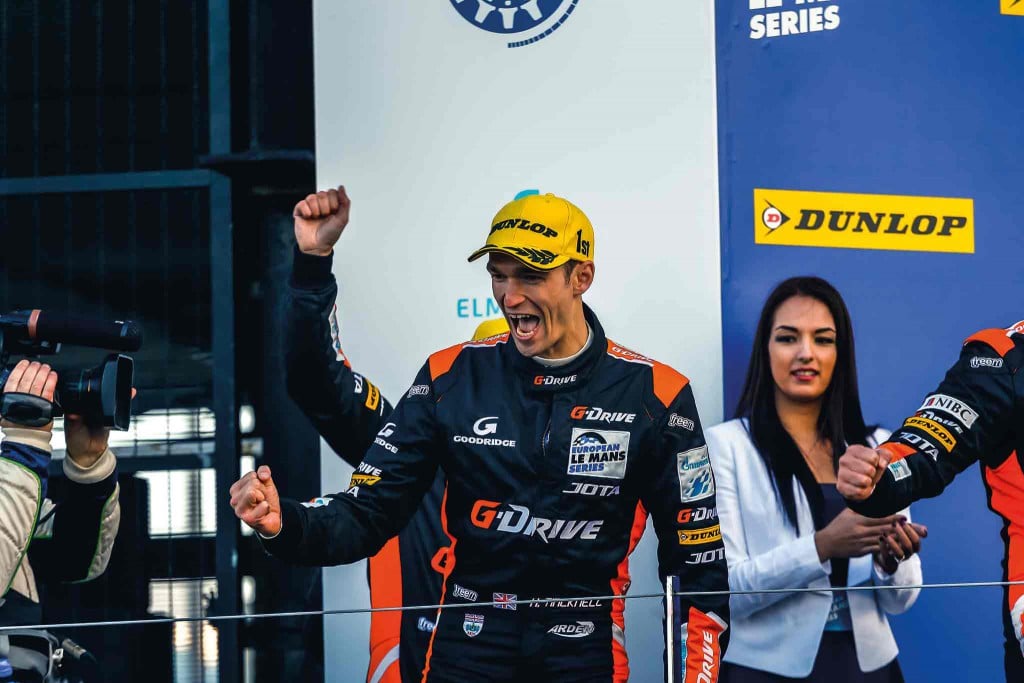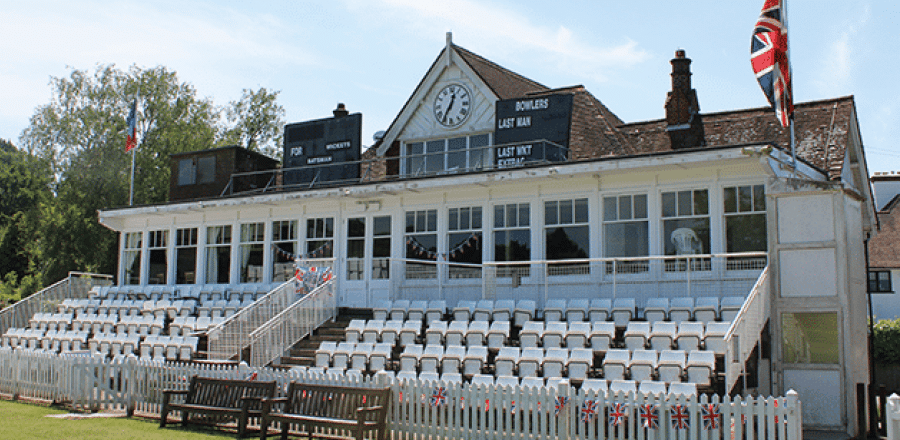At the age of 24, Harry Tincknell has already gained a reputation as one of the most soughtafter drivers in endurance motorsport.
Two years ago he won the renowned 24 Hours of Le Mans – in his first year with Jota Sport.
“That was the highlight of my career so far. It was such a buzz to cross the finish line knowing that 250,000 people had come to watch,” he said. “I couldn’t have asked for a better debut.”
Harry has remained with the team, competing in the European Le Mans series in the LMP2 category which caters for privately run teams, unlike the manufacturer class of LMP1.
It was by chance that he got into racing at all. Unlike many young drivers, his family had few ties to motorsport. He discovered his passion for speed while on holiday as a child.
“When I was seven we went on holiday and opposite the hotel was a go-karting track. I ended up doing that all day, every day for the entire trip.”
Born and raised in Exeter but now living in London, Harry was given his first kart for his eighth birthday and by the age of 11 he was competing in Karts at a national level. For the next five years he raced across Europe and then on the global stage.

He soon outgrew karting, winning numerous podium positions in Formula Renault – one of several feeder categories for Formula One – before moving up to Formula Three in 2011.
However, he admits that none of these achievements would have been possible if his family had not supported him: “Like in many sports you have to start out with family funding before you can prove yourself and get sponsored.
“In this regard I have been very lucky, as motorsport is not cheapest thing to get into. But I have been sponsored to some degree since I was 16 and have several of my original sponsors still backing me.”
His talent was spotted by the triple 24 Hours of Le Mans winner and ex-Formula One driver Allan McNish, who has mentored Harry throughout his career since karting.
It is a bond which Harry describes as ‘invaluable’, adding: “There is no one better to get advice from than him.”
McNish was not alone in noticing Harry’s potential and in 2014 he was given his first break in endurance racing when he was signed up by Jota Sport.
“My aim was to make a name for myself and I was lucky to start talks with a professional and successful team like Jota, who signed me up.
“Of course, that was the year we won 24 Hours of Le Mans and came second overall in the European Championship, so it was a great start for me and I was racing among the best.”

Like most sports the highs are often punctured by lows, one of which was watching his team mate and Jota co-owner Simon Dolan crash at Silverstone in 2014.
“It was horrific to witness and it does make you think about the dangers. Luckily he got out of it relatively unscathed.
“It was also sad because until that point we had been winning the race.”
A second low point came in September last year, when the team were favourites to win the Championship after coming first at the Paul Ricard circuit in the south of France.
However, three hours after the chequered flag, and with spirits on a high, post-race scrutiny found that a logistical error by the team meant one of their three drivers had remained in the car less than two minutes longer than the 90-minute maximum.
Due to the error, the team incurred a 45-second penalty on their time, pushing them to third in the penultimate race of the year and ultimately destroying their hopes of winning the Championship.
“It was heartbreaking,” admits Harry. “We had been on the podium and walked off the track as the unassailable champions but ultimately we came third overall and only three points behind the victors.
“But the pain has been turned into determination to win the title and we are going about it in an aggressive way.”

The team got off to a flying start in the current season after coming first at Six Hours of Silverstone last month.
Despite qualifying fourth for the race, it was only one lap before Harry had taken the team into first place, a demonstration of his ability as a driver.
His talents are based as much on mentality as physical fitness. “I just keep my mind clear when racing because I always drive best when I am not thinking.
“As soon as I see the lights change for the start of the race, I have a silent thought process. The moment you start thinking about people in front or behind, you make mistakes or do something silly.
“You have to be in the zone in order to push the car to the limit.”
“In terms of doing a 24-hour race, though, there is not masses you can do before hand to prepare for it.
“You rely on the team’s physio and nutritionists to ensure you don’t have to think too much but I am still mentally exhausted for the next three or four days afterwards.”
When the iconic Le Mans race began in 1923, it was not unknown for teams to use only one driver. But by the 1990s, with the speed of the cars increasing the strain of fatigue, drivers could not be at the wheel for more than four hours consecutively, and now teams use three drivers.
Although Harry says he is ‘very happy’ to carry on in endurance racing, he has not ruled out taking the ultimate step in his career.
“I may well do Formula One eventually and recently had my first go in an F1 car. But endurance racing is now of such high quality that it is no longer seen as secondary.
“The main problem with Formula One is that unless you are in the top three or four teams there is a serious lack of money so they do not necessarily chose drivers on results but on sponsorship – or big family money.
“This is not such an issue in the Le Mans series. But it all goes in cycles and I am sure when Bernie [Ecclestone, the F1 supremo] goes, money he has been taking out of the sport will start flowing back to the teams.
“So at the moment I am not too bothered about moving on. The team and I are in a really good place right now.”

A LITTLE BACKGROUND…
WHAT IS THE 24 HOURS OF LE MANS?
Established in 1923, it is the oldest active endurance race in the world.
It takes place every June in the northern French town of Le Mans, starting mid-afternoon on Saturday and ending 24 hours later on Sunday, with cars covering distances of over 3,000 miles. Consecutive rule changes since the 1980s mean a car must have at least three drivers, with each racing for a maximum stint of four hours at a time.
WHAT TYPE OF CARS ARE RACED?
Traditionally around 50 competing cars take part in the race split between Le Mans Prototypes (LMP) and GTs (Grand Tourer), each of which have their own sub-sets. The Prototypes, designed specifically for endurance racing, are the fastest sports cars in the world after F1 and split into two classes, LMP1 and LMP2.
The first of these is the preserve of the large manufacturers such as Nissan, Audi, Porsche and Toyota. Each car has a top speed of around 210mph. In 2014, Audi disclosed its annual budget for each Le Mans season was £167million.
LMP2 is exclusively for private teams such as Jota. They have similar characteristics and appearance to their larger counterparts, but respect strict financial criteria, with a maximum cost per car of £366,000 this year.
To run each car in LMP2 costs approximately £1,000 per hour and a season will set a team back roughly £4 million. Top speeds in this class are around 190mph.
The GT class has a similar two-category split, with GTE Pro consisting of Ferraris, Porsches, Corvettes and Aston Martins, reaching maximum speeds of 185mph, and GTE Am made up of smaller teams with amateur drivers.








